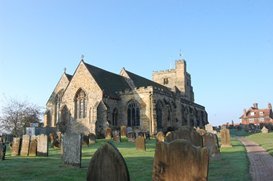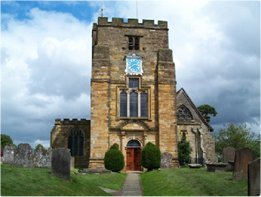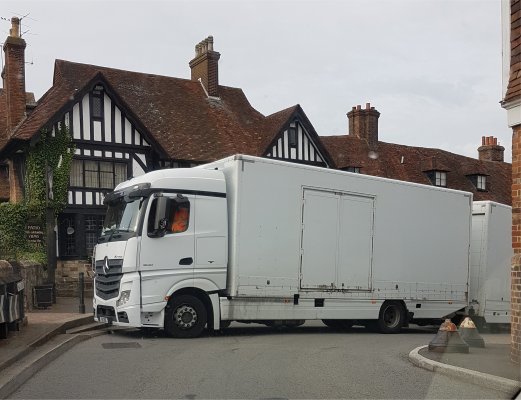Sitting at the top of the hill looking out over the surrounding countryside, St Mary's church is a landmark that can be seen from miles around. For this reason it was a major surveying point in the Anglo-French Survey (1784–1790) to measure the precise distance and relationship between the Paris Observatory and the Royal Greenwich Observatory, supervised by General William Roy. The first record of the church comes from 1119, and the church has been a Grade I listed building since 1967.
 |
Made from sandstone, the 13th-century church has aisles to the naves and side chapels in the chancel, and has been altered and restored many times over the centuries. The 115 feet tall spire and the tower were destroyed by lightning in 1637. In 1638 three London masons Edmund Kinsman, James Holman and John Young rebuilt the west tower in a truncated Classical/Gothic style. The distinctive clock face is early 20th-century.
|
Inside there is a simple arched piscina and a hollow chamfered ambry in the largely 19th-century chancel built based on excavations made during restorations in Victorian times. From 1865 to 1870 the church was restored by the architects William Slater and Richard Carpenter, the alterations being supervised by Ewan Christian. A further restoration by Carpenter alone in 1877 included the building of a vestry and a large part of the South aisle.
The nave is of five-bay arcades while the rood screens to the North and South chapels incorporate 14th (or possibly 15th-century) panelling with the upper section of the screen to the South chapel carved as a memorial to the fallen of the First World War.
|
The pulpit with its brass candlesticks and book rest stands on an octagonal stone base and steps with iron and brass rails. The body of the pulpit is 13th-century with figures of the apostles and evangelical symbols carved in relief. The brass lectern is 19th-century while the font in the nave has a 19th-century bowl with evangelical symbols and stands on a medieval (probably 15th-century) base.
The church features many monuments - In the north chapel are monuments to Edmond Roberts (died 1627), Richard Pack (died 1838) and Edward Lewis Miller (1831–1846), who died in a fall from a cliff on the Isle of Wight.
|
 |
In the chancel are memorials to William (d.1615) and Rachel (d.1606) Campion
In the south chapel can be found memorial brasses to John Bedgebury (died 1424); Sir John Culpepper (1424–1480), and Walter and Agnes Culpepper (died 1462 and 1457). Here also is the alabaster standing wall monument to 'Young' Sir Alexander Culpepper (1541–1599), erected in 1608 by his son Sir Anthony Culpepper.
Located in its own bay window is the important monument to 'Old' Sir Alexander Culpepper (died 1537),
The church was the location of the Battle of Goudhust. In 1747 a full-scale battle took place in the church and churchyard between the Goudhurst Militia under 'General' William Sturt (1718–1797), a former army corporal, and the Hawkhurst Gang, a large and notorious 18th-century smuggling group led by Thomas Kingsmill, a native of the village.
When he heard that the Militia had been formed Kingsmill became enraged and threatened to burn the village and kill the residents unless the Militia was disbanded and Sturt be handed over to the smugglers, setting an appointed time on Friday 21 April 1747. These demands not being met, when the gang attacked on the appointed day they approached heavily armed with many stripped to the waist to display their scars and tattoos in an act of bravado and intimidation. However, the Militia were well enough trained to shoot dead Kingsmill's brother George in their first volley. Two more smugglers died during the battle.
William Sturt spent his last years as Warden of Goudhurst Workhouse, while Kingsmill was hanged at Tyburn in 1749
 |
The church has been damaged many times since, but today’s battles are with the heavy goods vehicles ignoring the warning signs about the tight narrow road around the church.
The walls of the church bear testament to damage inflicted by the lorries which find themselves wedged against the churchyard’s wall many times each week.
|
To Find This Cache
Consider the Battle of Goudhurst which took place on AB-CD-EFGH
The cache can be found at-
N51 C (A+D) . H (D+E) C
E000 AF . (B+F) (A+H) (D+G)
which is a short walk away
****************** ********************
For full information on how you can expand the Church Micro series by sadexploration please read the Place your own Church Micro page before you contact him at churchmicro.co.uk
See also the Church Micro Statistics and Home pages for further information about the series.
****************** *******************